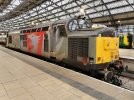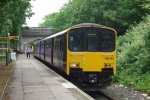-
Our new ticketing site is now live! Using either this or the original site (both powered by TrainSplit) helps support the running of the forum with every ticket purchase! Find out more and ask any questions/give us feedback in this thread!
You are using an out of date browser. It may not display this or other websites correctly.
You should upgrade or use an alternative browser.
You should upgrade or use an alternative browser.
Derailment at Kirkby (Merseyside) - 13/03/2021
- Thread starter tgsh2011
- Start date
- Status
- Not open for further replies.
Sponsor Post - registered members do not see these adverts; click here to register, or click here to log in
R
RailUK Forums
I'm lucky to see it this morningJust read on another forum that 37800 has departed Lime Street for Kirkby about an hour ago.
Attachments
edwin_m
Veteran Member
The video shows a buffer stop with both hydraulic and friction elements. I've never seen one like that on Network Rail, who seem to prefer friction-only (usually from Rawie).Certainly interesting but nowhere near the impact speed of the incident at Kirkby on Saturday evening, IMHO.
If I correctly recall, the kinetic energy of a moving object is proportionate to the square of its speed/velocity, so if a given mass is moving three times faster (30 mph vs 10 mph) it will have nine times as much energy to dissipate.
(30 mph vs 5 mph would have had 36 times more kinetic energy!)
An 'aggravating' factor at Kirkby will have been the near proximity of the buffer stop to the (solid?) walkway connecting platforms one and two, which must have surely have deflected the Merseyrail from its initial forward direction, and thus almost certainly derailed it.
Possibly just as well, also, that the underbridge was sufficiently wide (was the line through Kirkby once double track, back in the day?) that the train didn't stuff into the bridge abutments.
Anyone have a similar or contrary opinion on all this?
The friction buffer stop can bring a train to a halt much more gently if it has enough length behind it. They can also be designed to increase the retardation over distance, by adding more "shoes" clamping the rail behind the stop, which come into play as the stop slides back. That way a slow impact can have a gentle retardation but a more severe one can have the retardation build up over a short period that might be enough for passengers to brace for impact. While it may not have stopped at 30mph impact it would certainly have reduced its severity.
Mcr Warrior
Veteran Member
- Joined
- 8 Jan 2009
- Messages
- 15,008
Presumably then, such a buffer stop would have had to be located somewhat further distance back along the line towards the M57 overbridge / Fazakerley direction. Might also have meant a redesign of Kirkby station at platform level (at present, the length of platform is just about long enough to accommodate six carriage length electric multiple units) as well as a longer distance when interchanging between platforms one and two.
Bletchleyite
Veteran Member
Presumably then, such a buffer stop would have had to be located somewhat further distance back along the line towards the M57 overbridge / Fazakerley direction. Might also have meant a redesign of Kirkby station at platform level (at present, the length of platform is just about long enough to accommodate six carriage length electric multiple units) as well as a longer distance when interchanging between platforms one and two.
Well, it'd require a longer platform. Fortunately, looking at Google Earth, it doesn't look like that would be hard to achieve, even if it meant slewing the single line over.
It might be, though, that they can get away with just moving the buffer stops and not using double sets until the extension is built to Headbolt Lane which won't be that far off.
SuspectUsual
Established Member
- Joined
- 11 Jul 2018
- Messages
- 5,199
The video shows a buffer stop with both hydraulic and friction elements. I've never seen one like that on Network Rail, who seem to prefer friction-only (usually from Rawie).
The friction buffer stop can bring a train to a halt much more gently if it has enough length behind it. They can also be designed to increase the retardation over distance, by adding more "shoes" clamping the rail behind the stop, which come into play as the stop slides back. That way a slow impact can have a gentle retardation but a more severe one can have the retardation build up over a short period that might be enough for passengers to brace for impact. While it may not have stopped at 30mph impact it would certainly have reduced its severity.
Presumably the other downside of the hydraulic design is that an unbraked train would “rebound” once it was brought to a halt, which could have consequences of its own
Presumably the other downside of the hydraulic design is that an unbraked train would “rebound” once it was brought to a halt, which could have consequences of its own
Pardon how many unbraked do we have on the network nowadays?
Missed out the word train in my last post.
That buffer is pneumatic rather than hydraulic. The video states 'inflated to 20 bar'. Plus it's doubtful a hydraulic system would compress anywhere near as much.
Surely the only way a rail vehicle would rebound is if all of its forward momentum was absorbed and as you say it was unbraked (after the impact) - quite unlikely.
Surely the only way a rail vehicle would rebound is if all of its forward momentum was absorbed and as you say it was unbraked (after the impact) - quite unlikely.
SuspectUsual
Established Member
- Joined
- 11 Jul 2018
- Messages
- 5,199
That buffer is pneumatic rather than hydraulic. The video states 'inflated to 20 bar'. Plus it's doubtful a hydraulic system would compress anywhere near as much.
Surely the only way a rail vehicle would rebound is if all of its forward momentum was absorbed and as you say it was unbraked (after the impact) - quite unlikely.
You can see it happening in the video in post #286, that’s why I asked. But if the train being unbraked was the cause of the collision, it follows that it’d also be unbraked afterwards, and if it was still on the rails it could rebound
westcoaster
Established Member
Quite unlikely, for a start the drum switch on the leading damaged coupler would put the brakes on. Also I'm sure the force of the collision would have damaged the main air line.You can see it happening in the video in post #286, that’s why I asked. But if the train being unbraked was the cause of the collision, it follows that it’d also be unbraked afterwards, and if it was still on the rails it could rebound
Sorry if already posted does the unit type involved have the 12%G enhanced emergency brake, or does step 3 and emergency give the same brake force.
Pretty sure someone early on said the 507/508s don't have 12%g.
Also, people keep saying it's a 'concrete block' under the bridge. Looks very much in both the before and after photos like it was built up from building materials instead to me, and seems to have deformed as though it was too when the unit hit it. Surely if it was concrete the damage to the lower right corner of the 507 would be a lot more serious.
Also, people keep saying it's a 'concrete block' under the bridge. Looks very much in both the before and after photos like it was built up from building materials instead to me, and seems to have deformed as though it was too when the unit hit it. Surely if it was concrete the damage to the lower right corner of the 507 would be a lot more serious.
Last edited:
N95JPl
Member
There is a concrete block that sticks into the bridge, the rubble is from the opening between the concrete block (walk way) and the bridge wall;Pretty sure someone early on said the 507/508s don't have 12%g.
Also, people keep saying it's a 'concrete block' under the bridge. Looks very much in both the before and after photos like it was built up from building materials instead to me, and seems to have deformed as though it was too when the unit hit it. Surely if it was concrete the damage to the lower right corner of the 507 would be a lot more serious.
The front of the trains badly caved in on the right side but it’s just been deflected inside of crushing
Few points as someone from Kirkby originally.
The walkway under the bridge is now narrower than it was before the first crash. It was put in place in 1977.
There were two similar incidents in quite quick succession involving trains striking it. The buffer on the Liverpool side used to be much closer to the walkway before the initial incident. It was moved back after the first incident and meant that 6 car trains just about fit in the station.
Three car trains now stop about two carriage lengths short of the buffers (normally)
The walkway under the bridge is now narrower than it was before the first crash. It was put in place in 1977.
There were two similar incidents in quite quick succession involving trains striking it. The buffer on the Liverpool side used to be much closer to the walkway before the initial incident. It was moved back after the first incident and meant that 6 car trains just about fit in the station.
Three car trains now stop about two carriage lengths short of the buffers (normally)
Few points as someone from Kirkby originally.
The walkway under the bridge is now narrower than it was before the first crash. It was put in place in 1977.
There were two similar incidents in quite quick succession involving trains striking it. The buffer on the Liverpool side used to be much closer to the walkway before the initial incident. It was moved back after the first incident and meant that 6 car trains just about fit in the station.
Three car trains now stop about two carriage lengths short of the buffers (normally)
Originally the buffer stop was much closer to Liverpool. In 502/503 days that is. 6 car 502s were certainly a Tight fit.
Then it appears to have been moved Closer to Rainford. The walkway appears to be similar to how it is now. It’s entirely possible that what I thought was them widening it is actually the rebuild from the 1997 incident and maybe refurbishment of the bridge.
Last edited:
It wasn't
That’s exactly where it was prior to Saturday evening.
TheSel
Member
A 2010 image of Kirkby Station showing 507005 and a Pacer at their respective regular stopping places, and a 2018 image showing 150143 and an unidentified 507/8, from the opposite side. Both images mine.
Attachments
Last edited:
Bletchleyite
Veteran Member
Originally the buffer stop was much closer to Liverpool. In 502/503 days that is. 6 car 502s were certainly a Tight fit.
Then it appears to have been moved Closer to Rainford. The walkway appears to be similar to how it is now. It’s entirely possible that what I thought was them widening it is actually the rebuild from the 1997 incident and maybe refurbishment of the bridge.
Intriguing on those photos that the unit is shown with one door leaf closed. A fault, or for a reason, I wonder?
Intriguing on those photos that the unit is shown with one door leaf closed. A fault, or for a reason, I wonder?
I was wondering that myself, I thought maybe the set closest to the camera had been held open at first but then noticed the other set. Very odd. The Trailers doors appear to be ok, so it’s probably a fault.
Looking again at the photos, I’m not sure the buffer stop has ever moved. Perspective is a wonderful thing!
Matt9300
New Member
They should just lay the third rail to Wigan and remove the blocks altogether.
Isn't that the aim of the new 777's running a hybrid approach so that doesn't need to be done though?
Same would apply Ormskirk through to Preston
Out of scope for this but to the 777s have a Pantograph installed too?
9o
They don’t have pantographs as built but provision has been made in the design so that there is space for one to be installed if required, be it for AC or DC supply. Trials with a unit fitted temporarily with a battery should take place this summer. If the concept is proven successfully then a case will be made for larger batteries to be fitted. That would enable services to be extended some way beyond the limits of the 3rd rail.Isn't that the aim of the new 777's running a hybrid approach so that doesn't need to be done though?
Same would apply Ormskirk through to Preston
Out of scope for this but to the 777s have a Pantograph installed too?
9o
They don’t have pantographs as built but provision has been made in the design so that there is space for one to be installed if required, be it for AC or DC supply. Trials with a unit fitted temporarily with a battery should take place this summer. If the concept is proven successfully then a case will be made for larger batteries to be fitted. That would enable services to be extended some way beyond the limits of the 3rd rail.
I believe they’ll all have batteries for depot shunting, but as you say one will be fitted with larger batteries for trial longer running.
Admittedly this has been somewhat on-again off-again.
Wezz
Member
Does anyone know when they'll be skating the unit back to Kirkdale? wouldn't mind finding somewhere along the route to watch it 

Does anyone know when they'll be skating the unit back to Kirkdale? wouldn't mind finding somewhere along the route to watch it
I imagine in the dead of the night once services have finished.
Wezz
Member
The 777's have provision for a pantograph, they're not equipped with one at the moment though.Isn't that the aim of the new 777's running a hybrid approach so that doesn't need to be done though?
Same would apply Ormskirk through to Preston
Out of scope for this but to the 777s have a Pantograph installed too?
Does anyone know when they'll be skating the unit back to Kirkdale? wouldn't mind finding somewhere along the route to watch it
Well 37800 was just lurking when I was there around 3:30. They were digging around the damaged DMS and jacking it up as I watched.
They should just lay the third rail to Wigan and remove the blocks altogether.
Skelmersdale is more likely.
The trial is definitely on, but it is unlikely to commence until the first 777 is accepted by Merseyrail from Stadler and approval for the stock is received from the ORR. Covid has played havoc with the testing programme as technicians from Switzerland have been unable to travel back and forth freely.I believe they’ll all have batteries for depot shunting, but as you say one will be fitted with larger batteries for trial longer running.
Admittedly this has been somewhat on-again off-again.
- Status
- Not open for further replies.




